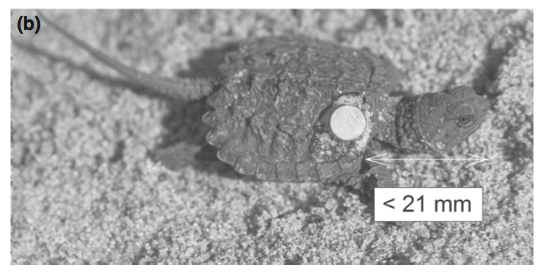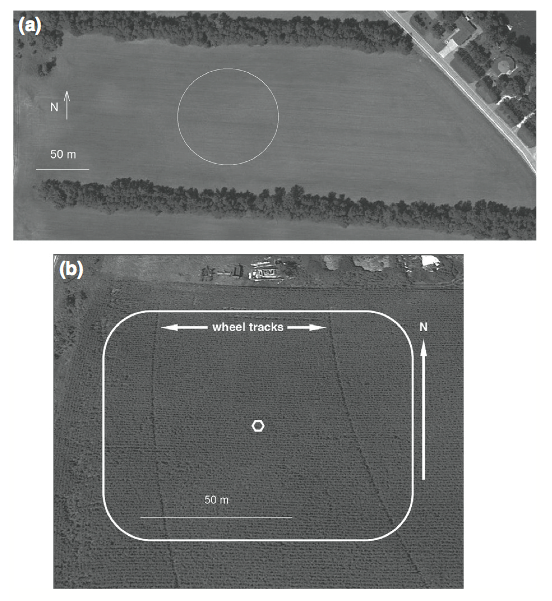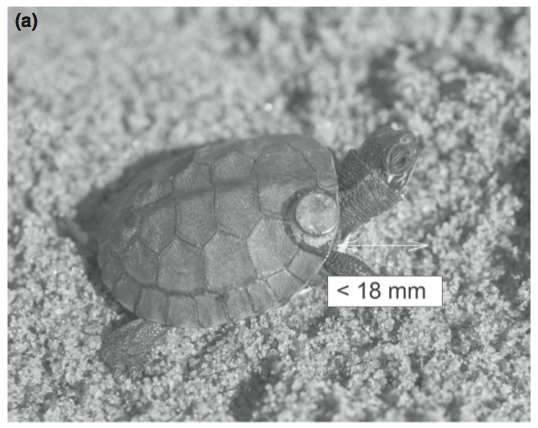We’ve all heard of the five senses: sight, touch, smell, sound, and taste. Some animals, such as certain types of fish, reptiles, or mammals, can also use an internal compass to navigate through their environment. This can be in the form of a sun-oriented compass, or a geomagnetic compass. Animals with a geomagnetic compass and use the Earth’s magnetic field to sense their environment. The use of this sense is a fairly new topic in sensory ecology, and it is unknown how it actually works and all of the animals that utilize it. Animals with a geomagnetic compass tend to have excellent homing abilities and can navigate to target habitats when displaced.
Turtles are one type of animal that have an exceptional homing ability when they are relocated to a new location. This is especially important for hatchlings because they need to be able to orient themselves when they first emerge from their eggs. Adults and hatchlings can face similar challenges when it comes to orienting themselves in a new area, but this can be particularly hard for hatchlings that have no previous experience of potential target habitats. Previous studies have established that freshwater turtles do use some sort of compass to maintain previously established headings, but researchers have been unsure as to whether this compass is related to the sun or a geomagnetic sense. A 2015 paper by Congdon et al. was the first to look at which type of compass hatchling freshwater turtles use when they first disperse from their nests.
The study examined two species of freshwater turtle: snapping turtles (Chelydra serpentina), and Blanding’s turtles (Emydoidea blandingii). Previous studies of these two species have indicated that they utilize visual cues to orient themselves but also exhibit compass learning. This was supported by the experienced turtles being better at maintaining their directionality when they are relocated. When hatchlings first emerge, they must immediately begin their journey towards the nearest water source. In the wild, Blanding’s turtles travel an average of 589 m, and typically travel towards dark horizons. Snapping turtles, on the other hand, travel an average of 75 m, and disperse towards illuminated horizons. Previous work has shown that if the naïve hatchlings are placed in a tall crop field that blocks their visual access to natural environmental cues, they will not show the directionality typically exhibited in their natural habitat. The researchers in this study used this knowledge to design a study that examined the type of compass that the hatchlings were utilizing: sun or geomagnetic.

Fig. 2: The placement of the magnets (and shams) on the anterior carapace of hatchling (a) Blanding’s turtles and (b) snapping turtles showing the maximum distances from the magnet to the tip of their snouts (photos by Jerry Olson).
The research group looked at a few different categories of hatchling turtles for testing: Naïve hatchlings that had never been exposed to environmental cues, arena-experienced hatchlings that were able to roam the arena before testing, and natural-experienced hatchlings that were captured while dispersing from their nests in the wild. Half of the turtles in each group had magnets glued onto their backs to disrupt the Earth’s magnetic field, while the rest had shams as a control. The first test arena consisted of a 100-m diameter mowed field, with open, light horizons on the East and West sides, and trees on the North and South sides that created a dark horizons. These different horizons were created to mimic the typical environmental cues for the two turtle species (light for snapping turtles and dark for Blanding’s turtles). Other arenas were constructed that had tall corn crops on all sides that blocked the horizon. Groups of hatchlings were released into the arena, and their location was recorded after 1 hour. The researchers were most interested to see if the hatchlings’ movements had directionality meaning they had a target location. The use of a corn field arena also allowed the researchers to disrupt the turtles’ visual cues and only look at the possibility of a magnetic compass. The researchers hypothesized if hatchlings did have a magnetic compass, then the turtles with magnets disrupting the magnetic field would not be able to maintain their previous heading compared to the control groups.

Fig 1. Aerial photograph showing the placement and shape of the (a) field arena in relation to the large dark tree rows and open ends of the field and (b) the corn arenas in 2012 and 2013 (hexagon=release area, and horizontal arrows indicate the location of irrigation wheel tracks and indicate the primarily E-W orientation of the corn rows).
They found that overall, visual environmental cues rather than a geomagnetic sense were the most important factors in hatchling turtle orientation. Naïve turtles released into the field arena exhibited directionality towards the man-made horizons, but this was not seen in those released in the corn arena. The corn arena blocked the typical visual cues that allows the turtles to have a target location, so their dispersal was more random. The arena-experienced group did show more directionality in the corn arena compared to the naïve group, meaning that they were able to learn directionality from their short dispersal into the field arena. Tests with natural-experienced turtles showed that a geomagnetic compass was not used as they did not orient themselves towards the horizons created in the arena but instead maintained the previously established orientation when released into either arena. This orientation was instead based on their previous knowledge of the relation of the sun to their target location. The presence or absence of a magnet had no effect on the directionality of any of the hatchling groups’ movements.
The researchers concluded that freshwater turtle hatchlings rely on a sun compass rather than a geomagnetic compass to orient themselves towards target habitats. This reliance is learned, however, as natural-experienced turtles could maintain the proper dispersal heading rather than move towards the man-made horizons in the arena. The results of this study do not prove that a geomagnetic compass does not exist in freshwater turtles. They instead highlight the importance of environmental cues in a hatchling’s ability to orient itself in the proper direction. Hatchlings learn from their surroundings, and use the sun to orient and navigate towards target areas. They can use this knowledge later on in life when they are displaced or need to travel to important areas again. More studies exploring the possibility of a geomagnetic compass in freshwater turtles should be done to confirm or deny its use and presence.
For more information about this topic see the full article:
Congdon, J. D., Pappas, M. J., Krenz, J. D., Brecke, B. J., & Schlenner, M. (2015). Compass Orientation During Dispersal of Freshwater Hatchling Snapping Turtles (Chelydra serpentina) and Blanding’s Turtles (Emydoidea blandingii). Ethology, 121(6), 538-547.

